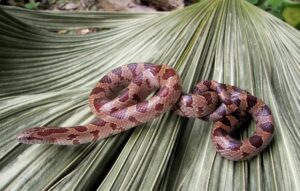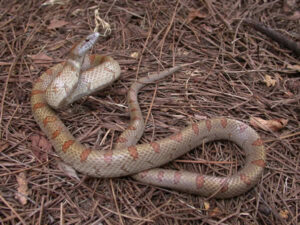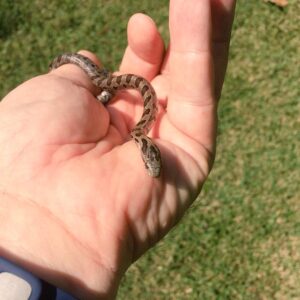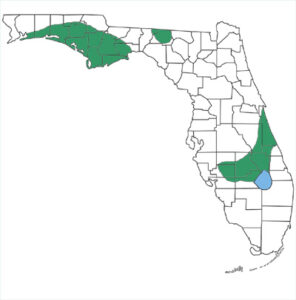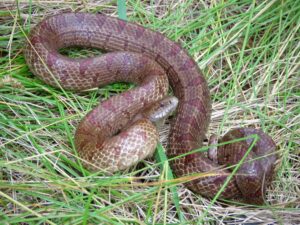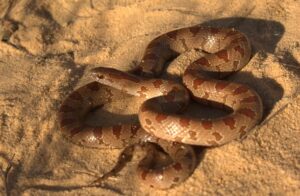The mole kingsnake, northern mole kingsnake, or brown kingsnake is a medium-sized colubrid that occurs in a variety of habitats. The specific name, rhombomaculata, is derived from ‘rhombus’ referring to the rhomboid-shaped dorsal blotches on its body, and ‘macla’ meaning spots.
Scientific Classifications
- Suborder:Serpentes
- Family:Colubridae
- Genus:Lampropeltis
- Species:L. rhombomaculata
Conservation Status
Description
Size
The serpent can reach a total length (including the tail) of 30-40 in (76.2-101.6 cm).
Color and Appearance
The mole kingsnake is generally gray or light brown in color, with orange, dark brown, or reddish brown blotches down the length of the body. The juveniles have more vivid patterns and colors with small reddish marks on their heads.
Are They Dangerous to Humans
The non-venomous, secretive snake is typically of a docile nature. If harassed, it vibrates its tail rapidly.
Mole Kingsnakes at a Glance
Distribution
Its range extends from Baltimore in Maryland, south through the Florida Panhandle, and west into Tennessee and Mississippi. It occurs in the southeastern US, except in the Appalachian Mountains.
Habitat
The mole kingsnake prefers open fields with loose, dry soil, typically in forest edges. The primarily nocturnal snake is commonly seen on paved roads at night. Being highly fossorial, it is rarely seen above the ground during the day except when driven out by heavy rains.
Lifespan
It lives for 15-20 years in captivity.
Predators
Eastern kingsnakes, hawks, owls, skunks, opossums, foxes, and raccoons are its predators.
Diet
The serpent mainly eats rodents but can also prey on frogs, lizards, and, occasionally, other snakes. It consumes its food whole and headfirst, even prey with diameters over 90% the diameter of its head.
Reproduction
Oviparous (lays eggs that hatch outside the body)
Mating occurs from late spring to early summer in the months of May to June. The females leave behind pheromone trails for the males to sense with their forked tongues. Post-mating, she lays 10-12 eggs in underground nesting sites and decaying logs. They hatch in summer, but the mother doesn’t stay back to take care of the young. In fact, she leaves the night she lays the eggs. The hatchlings take around 10 days to be fully independent.
Source
floridabackyardsnakes.com, srelherp.uga.edu, pbs.twimg.com, ufwildlife.ifas.ufl.edu, marylandbiodiversity.com, reddit.com

